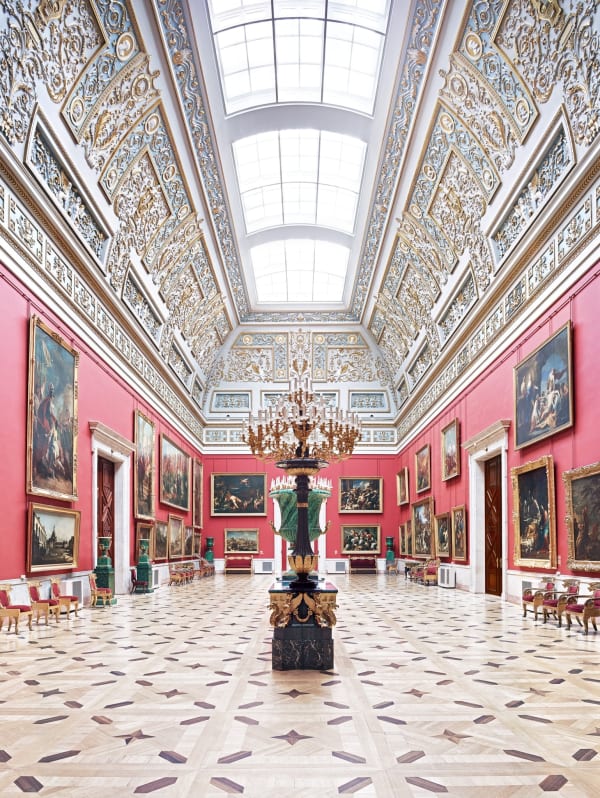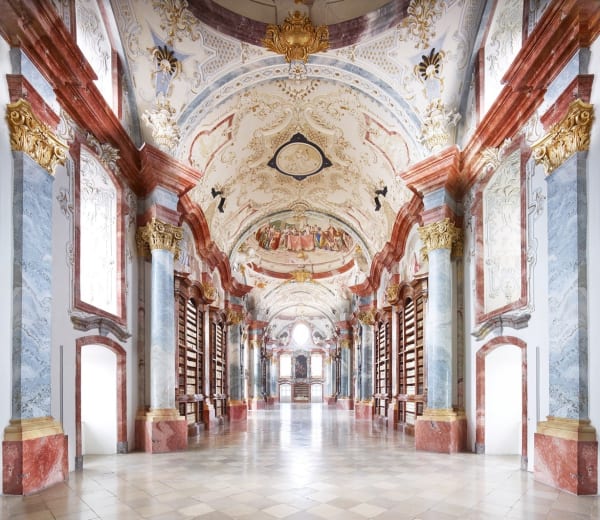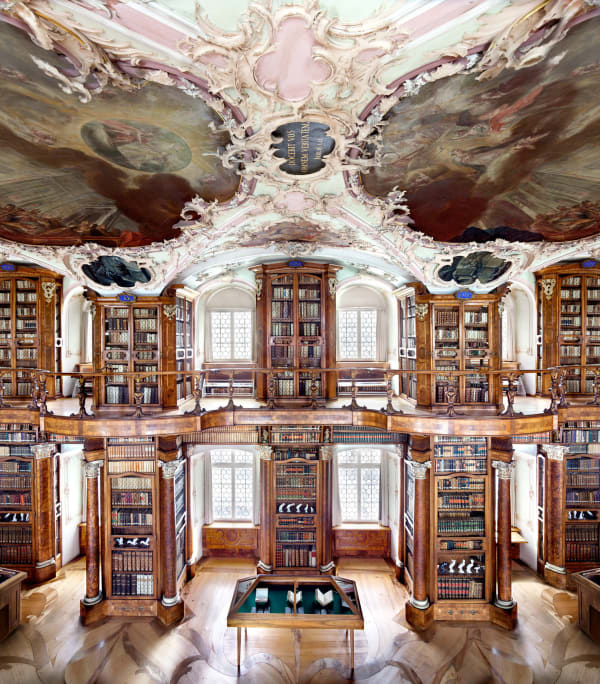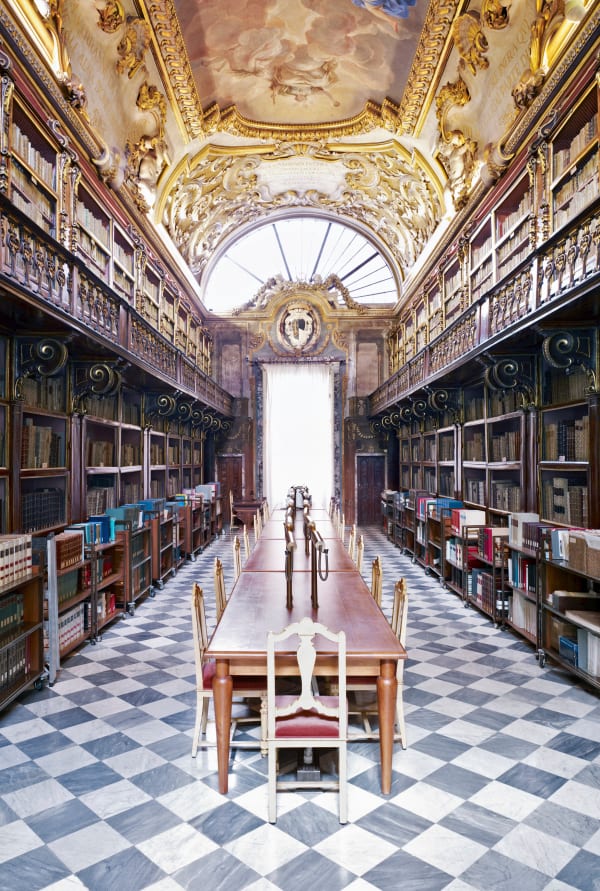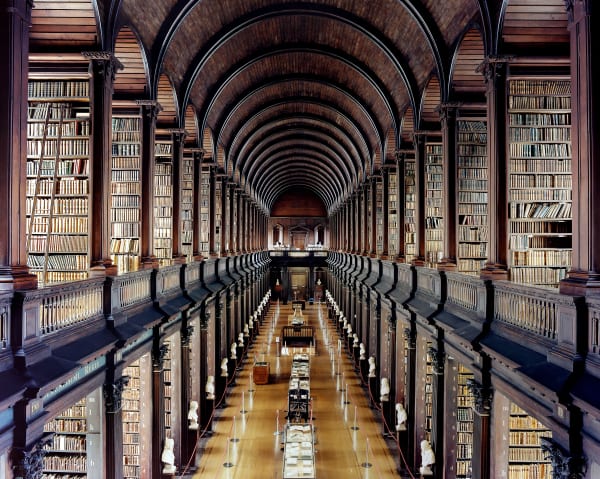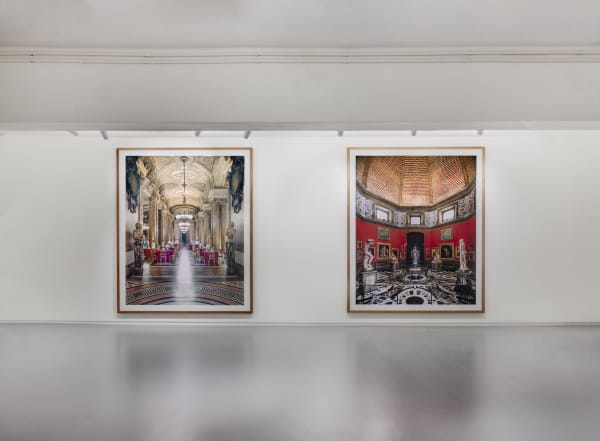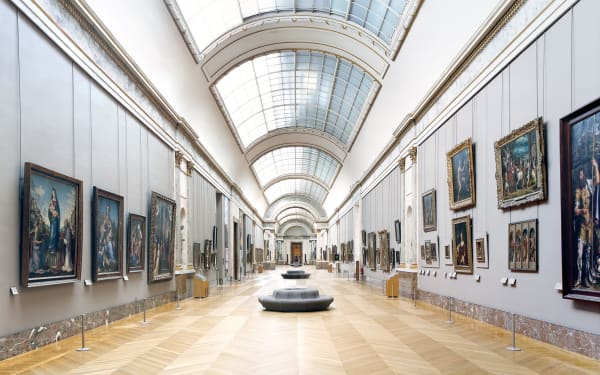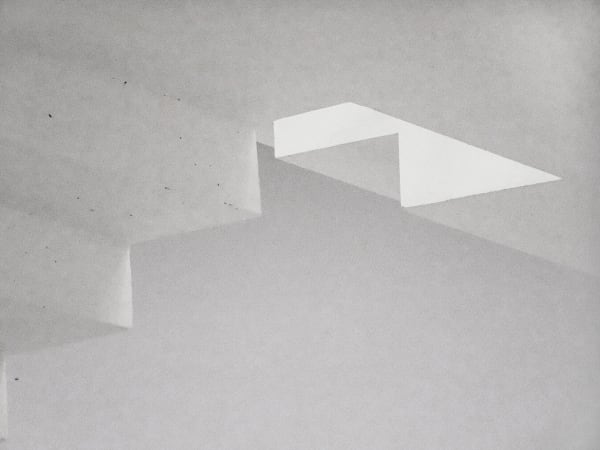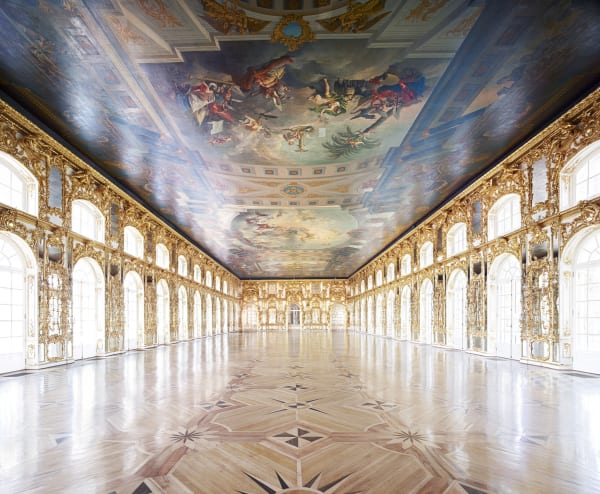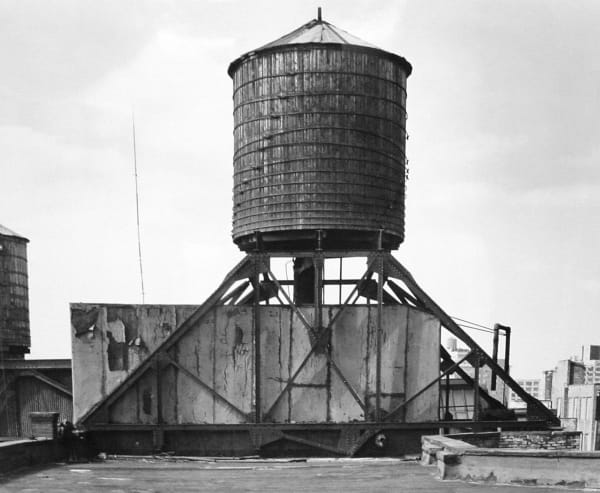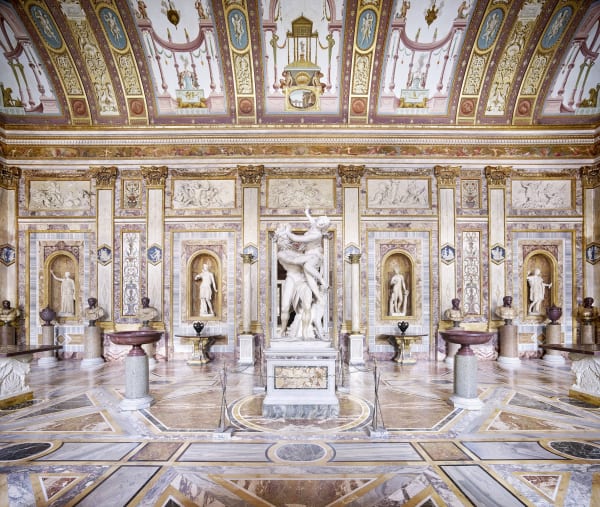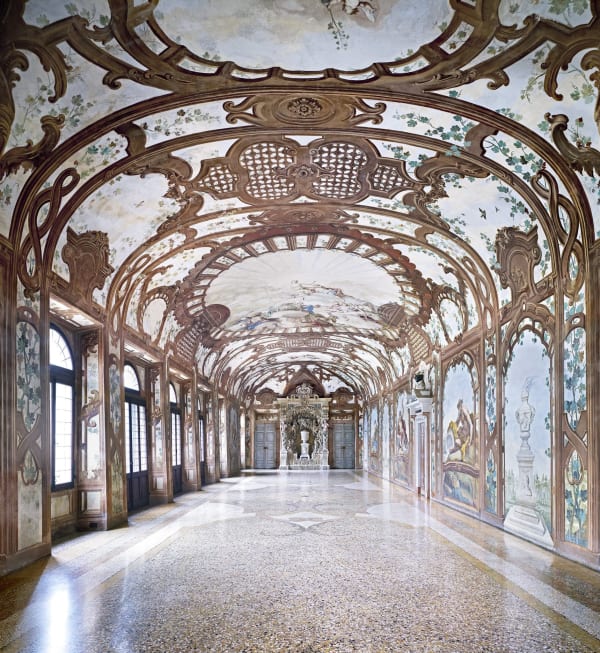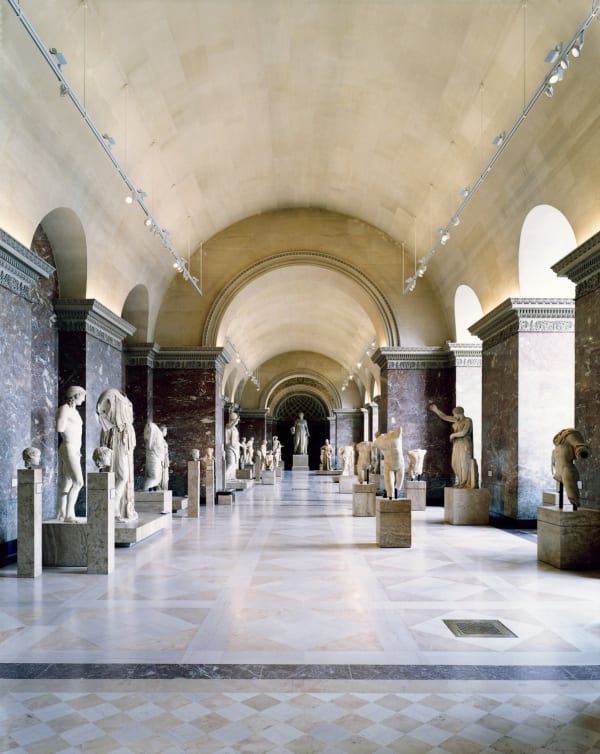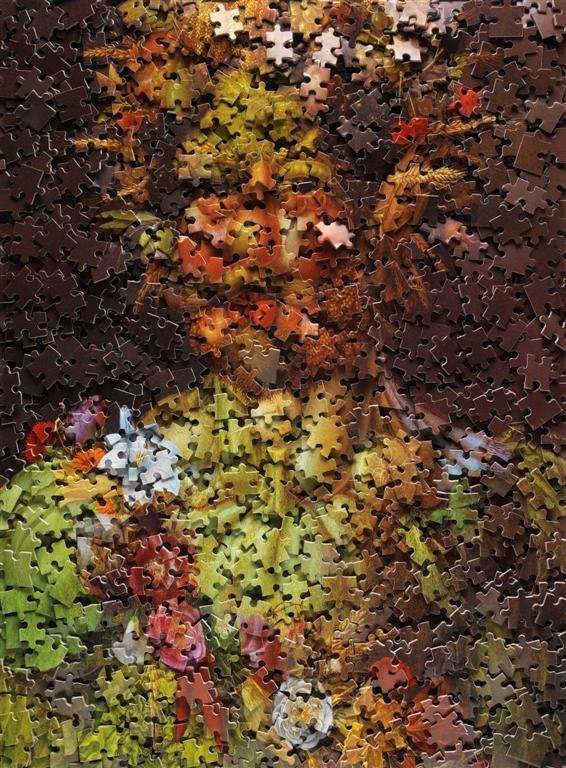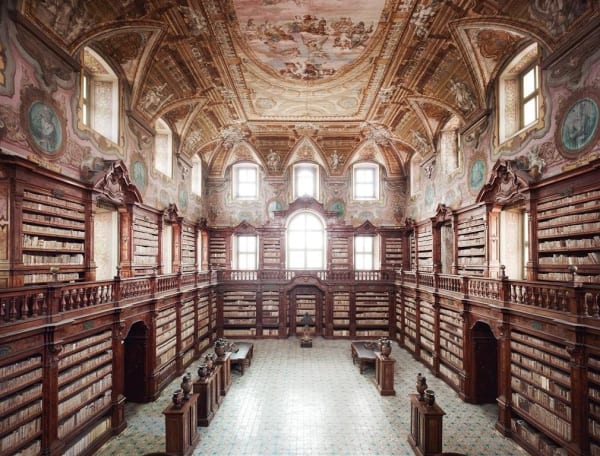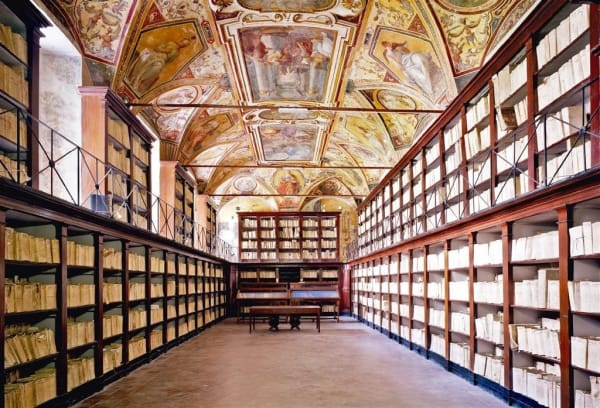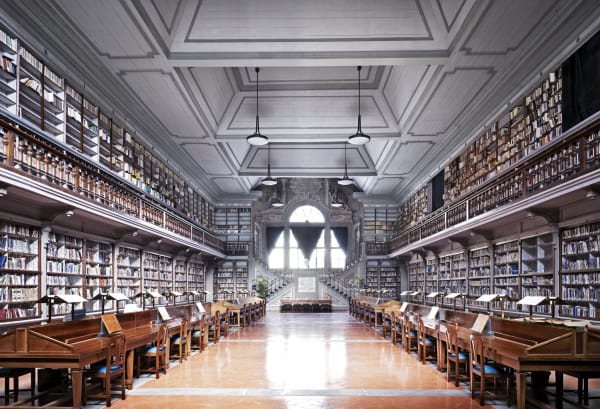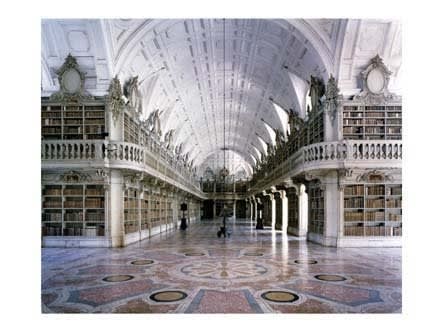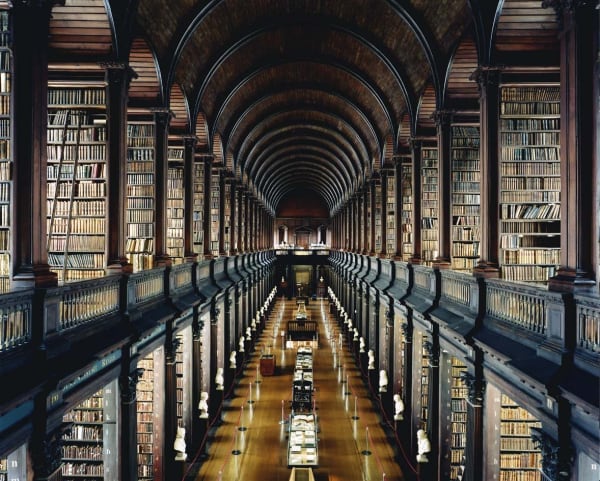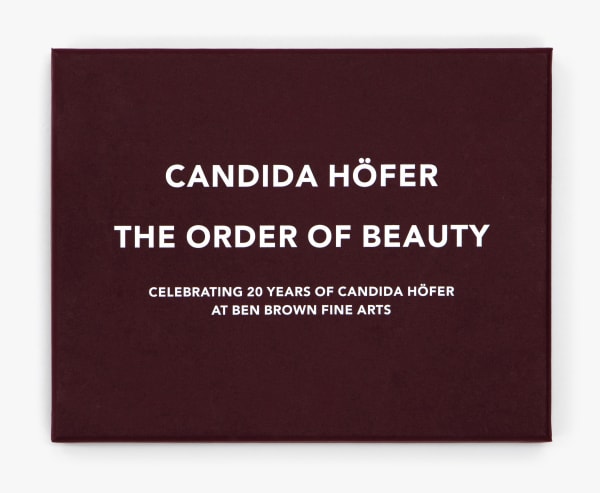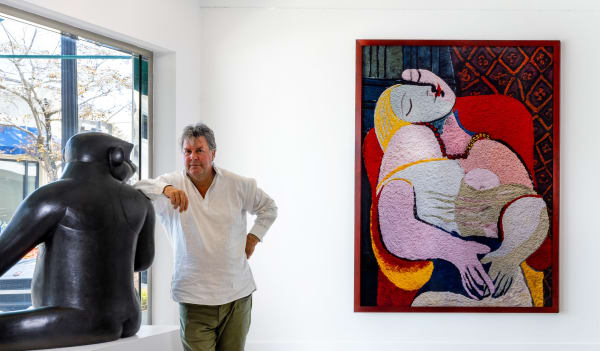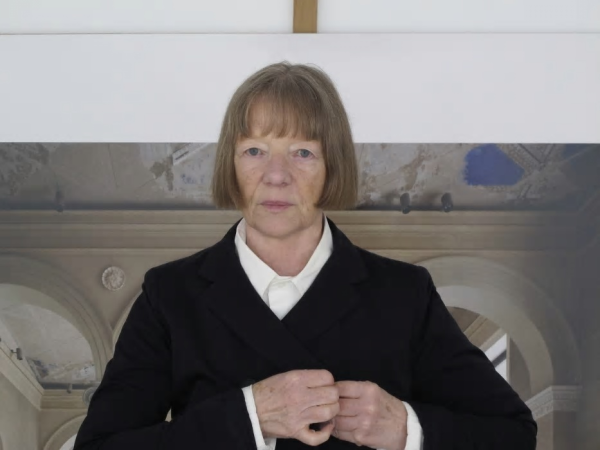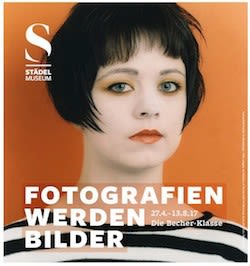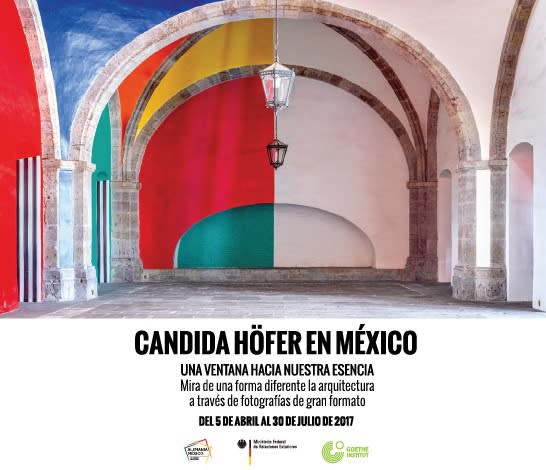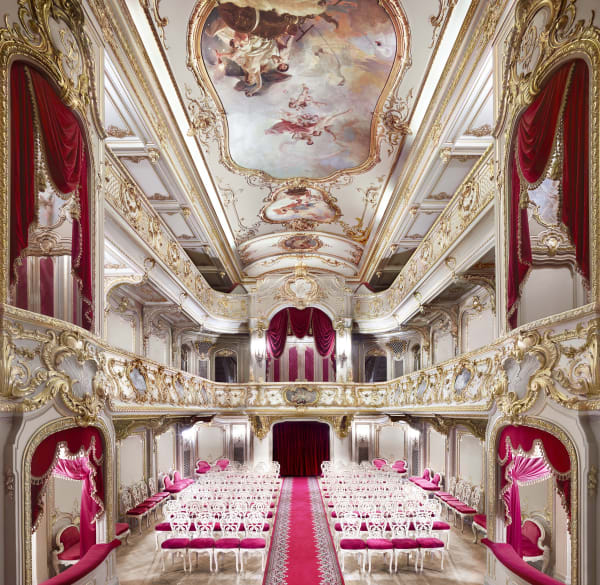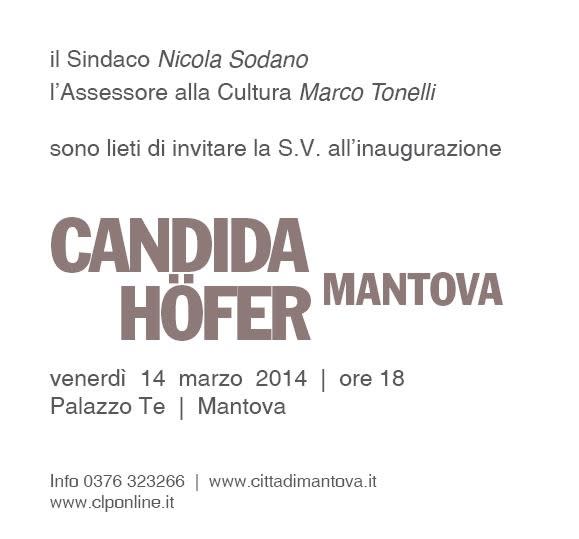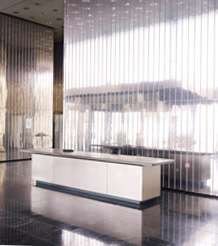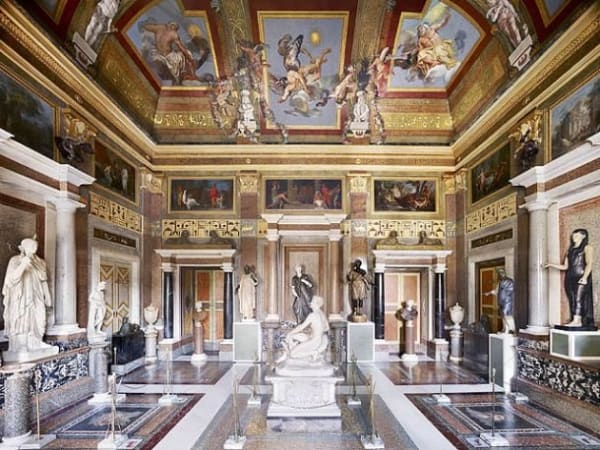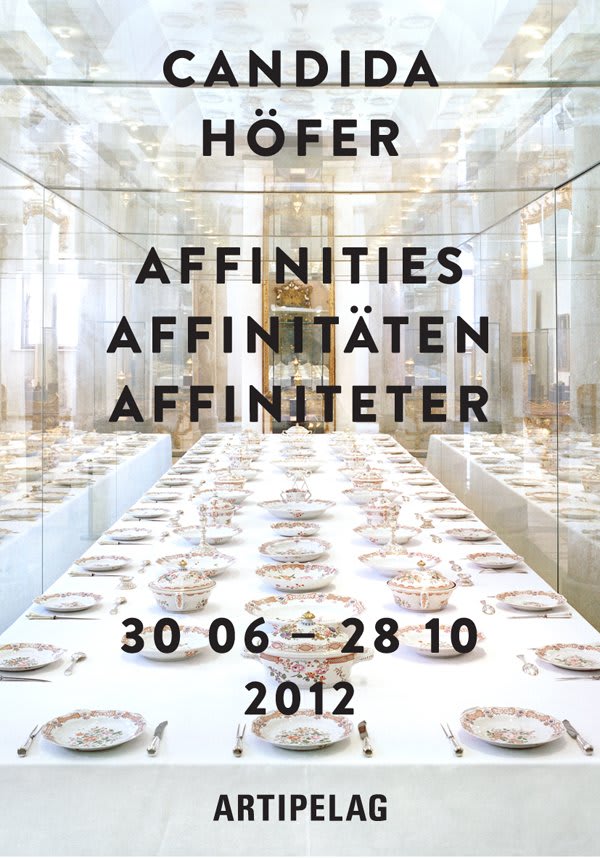Overview
Candida Höfer, born in Eberswalde, Germany, in 1944, is renowned for her large-scale photographs of uninhabited architectural interiors. Her work primarily focuses on cultural, institutional, public, and civic spaces, including libraries, museums, theatres, opera houses, universities, palaces, and zoos. The striking absence of human figures in her photographs imparts an eerie sense of grandeur, inviting contemplation of the architectural forms and the significance of the absent inhabitants in relation to public and private spaces. Rather than imposing a particular interpretation, Höfer presents these vacant public interiors with an objective, democratic, and almost encyclopaedic lens, capturing the pure essence and character of each room and its furnishings. Höfer’s meticulously composed photographs are unpretentious, precise, and serene, engaging with the pictorial poetics of absence and the psychological effect of architecture.
Höfer began studying at the Düsseldorf Art Academy under the influential photographers Bernd and Hilla Becher in 1976. In 2003, Höfer represented Germany at the 50th Venice Biennale, and in 2002 she participated at Documenta 11. Her work has been shown at the Kunsthalle Basel, Basel; Kunsthalle Bern, Bern; Musée du Louvre, Paris; Irish Museum of Modern Art, Dublin; and The State Hermitage Museum, St Petersburg. Her photographs are part of major museum collections across the globe, including the Tate Modern, London; Centre Georges Pompidou, Paris; Museo Nacional Centro de Arte Reina Sofía, Madrid; Museum Folkwang, Essen; Kunsthalle Hamburg, Hamburg; Museum of Modern Art (MoMA), New York; and The State Hermitage Museum, St Petersburg.
Enquire
Works
Exhibitions
-

Candida Höfer: The Order of Beauty
Celebrating 20 Years of Candida Höfer at Ben Brown Fine Arts 28 Nov 2024 - 28 Feb 2025 LondonBen Brown Fine Arts is delighted to present Candida Höfer: The Order of Beauty, an exhibition showcasing a selection of works by the esteemed German photographer Candida Höfer at the London gallery. This exhibition marks twenty years since Höfer’s debut with the gallery, celebrating a longstanding and fruitful collaboration that began with the seminal 2004 show, Libraries. As one of the first artists to join Ben Brown Fine Arts, Höfer returns for her thirteenth solo exhibition at the gallery, affirming her enduring significance in contemporary photography and the evolving depth of her artistic practice.Read more -

Candida Höfer: Uninterrupted Space
10 Dec 2022 - 25 Feb 2023 Hong KongBen Brown Fine Arts is pleased to announce an exhibition of select works by German artist Candida Höfer at the Hong Kong gallery, 10 December 2022 to 25 February 2023....Read more -

Candida Höfer: Libraries, Museums and A Theatre
22 Nov 2021 - 25 Jan 2022 LondonBen Brown Fine Arts is honoured to announce Libraries, Museums and A Theatre , an exhibition of selected works by legendary German artist Candida Höfer. This is the artist's eleventh...Read more -

Ben Brown Fine Arts:
15 Jun - 31 Aug 2020 Hong Kong
Celebrating 10 years in Hong KongBen Brown Fine Arts is pleased to present an extraordinary group exhibition inaugurating the Hong Kong gallery's new location in Wong Chuk Hang and celebrating our 10 year anniversary in...Read more -

Candida Höfer
28 Nov 2019 - 23 Jan 2020 London
Showing and SeeingBen Brown Fine Arts is proud to present an exhibition of selected works by esteemed gallery artist Candida Höfer at the London gallery from 28 November 2019 to 25 January...Read more -

DARKROOM | A Group Show
27 Jul - 15 Sep 2018 Hong Kong
Kitty Chou, Candida Höfer, Vik Muniz and Hiroshi SugimotoBen Brown Fine Arts is thrilled to present our summer exhibition, Darkroom , at the Hong Kong gallery from 28 July to 15 September 2018. The show will bring together...Read more -

CANDIDA HÖFER
Memory: Selected Works from the State Hermitage Museum Exhibition 2015 22 Mar - 28 May 2016 Hong KongAfter receiving critical acclaim at the State Hermitage Museum in 2015, Candida Höfer's latest series, Memory - capturing the splendour of St Petersburg and its magnificent buildings - will travel...Read more -

CANDIDA HÖFER
Memory: Selected works from The State Hermitage Museum exhibition 2015 13 Oct - 27 Nov 2015After receiving critical acclaim at the State Hermitage Museum this summer, Candida Höfer's latest series, Memory (2014) - capturing the splendour of St Petersburg and its magnificent buildings - will...Read more -

DUSSELDORF PHOTOGRAPHY
Bernd & Hilla Becher and Beyond 4 Sep - 3 Oct 2015 LondonThis autumn Ben Brown Fine Arts is pleased to present a major survey of photography originating from the Kunstakademie Düsseldorf after 1976. The exhibition offers an opportunity to see varying...Read more -

PHOTOGRAPHY NOW
An International Survey 23 Apr - 27 May 2015 LondonRead more -

CANDIDA HÖFER
Villa Borghese 25 Jun - 3 Oct 2014 LondonBen Brown Fine Arts is proud to present Candida Höfer's Villa Borghese series on 25 June. Höfer's Libraries was the inaugural exhibition at Ben Brown Fine Arts' Cork Street space...Read more -

CANDIDA HÖFER
A Return To Italy 12 Feb - 12 Apr 2013 LondonGerman photographer Candida Höfer makes a significant return to Ben Brown Fine Arts in London on 12 February with a major solo show, unveiling thirteen new and previously unseen photographs...Read more -

German Photography 1960 - 2012
A Survey 1 Mar - 5 May 2012 Hong KongBernd and Hilla Becher Thomas Demand Günther Förg Andreas Gursky Candida Höfer Axel Hütte Anselm Kiefer Jürgen Klauke Astrid Klein Imi Knoebel Sigmar Polke Gerhard Richter Thomas Ruff Thomas Struth...Read more -

Accrochage - Gallery Artists +++
Tony Bevan, Caio Fonseca, Adam Fuss, Damien Hirst, Candida Höfer, Heinz Mack, Martin Mull, Vik Muniz, Tseng Kwong Chi, Yan Pei Ming, Marc Quinn 3 - 27 Feb 2012 Hong KongRead more -

Photography Group Exhibition
31 Mar - 7 May 2011 Hong KongNobuyoshi Araki Candida Höfer Vik Muniz Thomas Ruff Hiroshi SugimotoRead more -

CANDIDA HÖFER
In Italy: Florence and Naples 27 May - 10 Jul 2010 Hong KongBen Brown Fine Arts is pleased to announce a solo exhibition of works by internationally-renowned German photographer Candida Höfer running from May 25th to July 10th at Ben Brown Fine...Read more -

CANDIDA HÖFER
In Italy Part II: Naples 23 Nov 2009 - 21 Jan 2010 LondonBen Brown Fine Arts announces two consecutive exhibitions by the German photographer Candida Höfer. The first exhibition, 'Candida Höfer in Italy, Part I: Florence' will open in London at the...Read more -

CANDIDA HÖFER
In Italy Part I: Florence 7 Oct - 11 Nov 2009 LondonBen Brown Fine Arts announces two consecutive exhibitions by the German photographer Candida Höfer. The first exhibition, 'Candida Höfer in Italy, Part I: Florence' will open in London at the...Read more -

CANDIDA HÖFER
Palaces, Theatres, Churches and a Casino 5 Jul - 28 Sep 2007 LondonBen Brown Fine Arts is proud to present an exhibition of photographs by Candida Höfer. Taken in both public and private places, she focuses on the interiors of spaces, centers...Read more -

Candida Höfer
Libraries 4 Oct - 4 Dec 2004 LondonRead more
Publications
-

Dusseldorf Photography
Bernd & Hilla Becher and Beyond 2015 Read more -
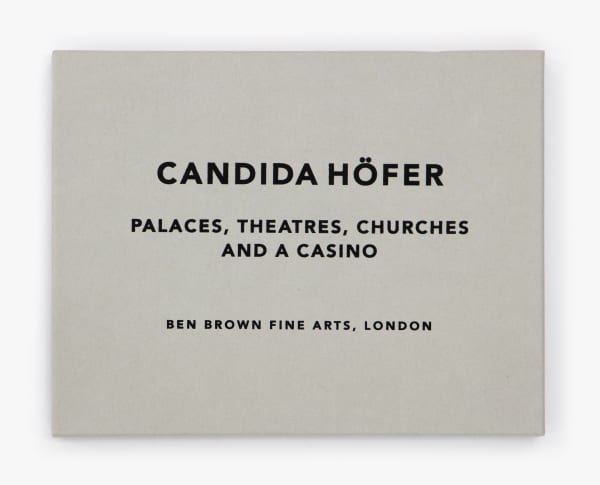
Candida Höfer
Palaces, Theatres, Churches and A Casino 2007Box of cards, 27 pagesRead more -
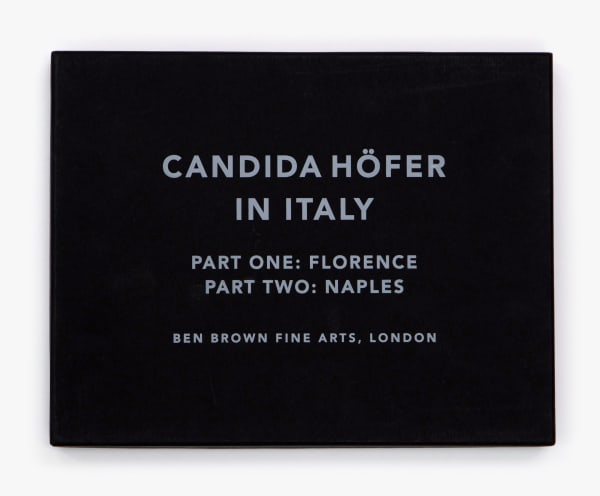
Candida Höfer
In Italy: Florence and Naples 2010Box of cards, 29 pagesRead more
Dimensions: 18.1 x 23.2 cm -

Candida Höfer
A Return To Italy 2013Box of cards, 22 pagesRead more
Dimensions: 18.1 x 23.2 cm
-
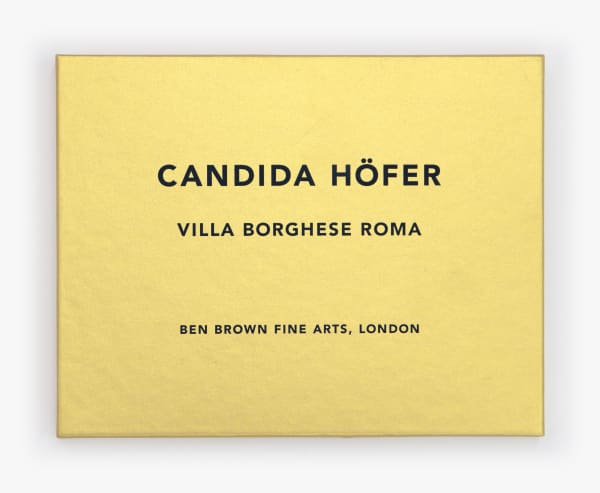
Candida Höfer
Villa Borghese 2014Box of cards, 20 pagesRead more
Dimensions: 18 x 23 cm -
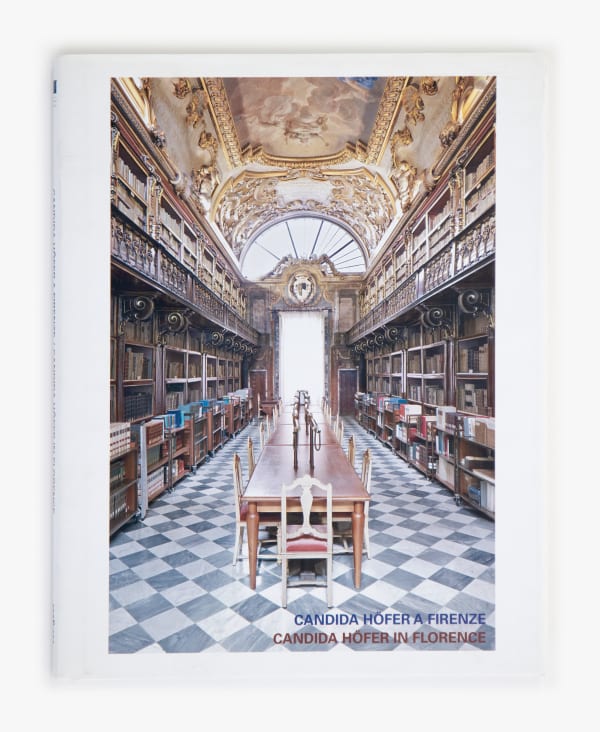
Candida Höfer
Candida Höfer a Firenze / Candida Höfer in Florence 2008Hardback, 72 pagesRead more
ISBN: 978-8863940091
Dimensions: 22 x 29 cm -
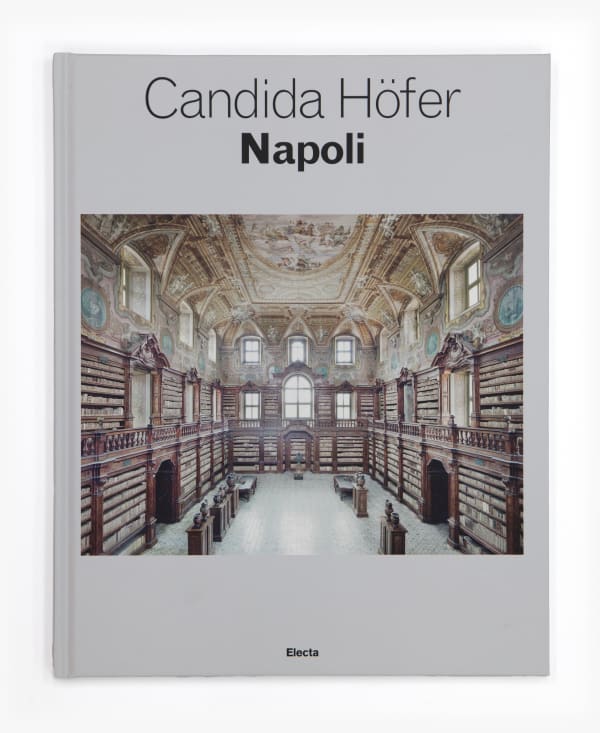
Candida Höfer
Napoli 2009Hardback, 48 pagesRead more
ISBN: 978-88-370-7369-5 -
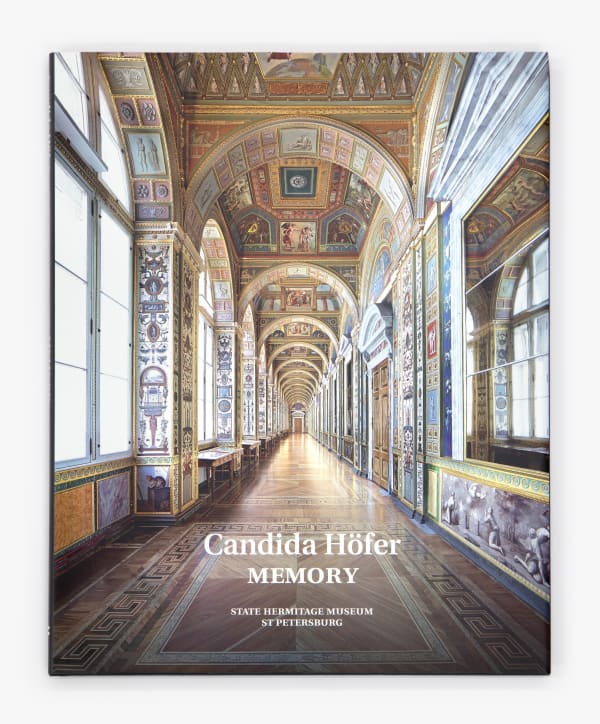
Candida Höfer
Memory 2015Hardback, 72 pagesRead more
Dimensions: 30.6 x 24 cm
News
-

New works by Candida Höfer: Illuminations from the darkroom
Stefan Trinks for Teller Report January 6, 2023The photographer Candida Höfer is baffled in the Liechtenstein Art Museum and in the Hilti Art Foundation – there is no trace of the typical...Read more -

VISION AND VIRTUE
Mark Westall for FAD Magazine October 12, 2022Ben Brown Fine Arts has just opened Vision and Virtue, an exhibition presented at Claridge’s ArtSpace in London, in the heart of Mayfair being held...Read more -

Candida Höfer composes staggering portraits of vacant public spaces
Emily Mcdermott for Wallpaper March 28, 2022We profile German photographer Candida Höfer, who is known for powerful large-format photographs of public spaces around the world. Although many might call her an...Read more -

In the presence of absence: inside Candida Höfer’s unpeopled public buildings
Christian House for FT Magazine February 20, 2022Some 20 years ago, a friend and I got shut inside Hamburg’s Kunsthalle. It was winter, late afternoon and dark. It simply closed on us...Read more
-

In middle of hot art market, Ben Brown Fine Arts opens Worth Avenue gallery
Bill DiPaolo for the Palm Beach Daily News June 13, 2021A grinning, 4-foot-high cast bronze gorilla sitting in the front window has been drawing attention from pedestrians since Ben Brown Fine Arts opened in early...Read more -

CANDIDA HÖFER at Hall Art Foundation | Schloss Derneburg Museum
February 20, 2019Hall Art Foundation | Schloss Derneburg Museum Visitor Center Astenbeck 42 31188 Holle Germany April - October 2019 The Hall Art Foundation will be exhibiting...Read more -

CANDIDA HÖFER awarded as Outstanding Contribution to Photography recipient at 2018 Sony World Photography Awards
February 15, 201815 February 2018 We would like to congratulate Candida Höfer on winning this prestigious award. The artist will receive her award at a ceremony held...Read more -

CANDIDA HÖFER: Modes of Behavior towards People When Affection Plays a Part. Klein Collection
at Kunstmuseum Stuttgart, Stuttgart July 18, 201715 July - 5 November 2017 Alison and Peter W. Klein have been collecting art for nearly thirty years. Continually expanded since the end of...Read more
-

CANDIDA HÖFER: Für Barbara
at the Hall Art Foundation, Schloss Derneburg Museum, Holle July 5, 20171 July - 30 December 2017 The Hall Art Foundation is pleased to announce a group exhibition, Für Barbara , to be held at its...Read more -

CANDIDA HÖFER: Ways to See Brazil: 30 Years of Itaú Cultural
at Itaú Cultural, São Paulo June 14, 201725 May - 13 August 2017 How many Brazils would fit in the Oca? After 30 years of great accomplishments, Itaú Cultural is filling this...Read more -

CANDIDA HÖFER: Photographs Become Pictures
at Städel Museum, Frankfurt June 6, 201727 April - 13 August 2017 The Städel Museum is staging a comprehensive survey on the Becher Class at the Düsseldorf art academy and the...Read more -

CANDIDA HÖFER in Mexico
at Antiguo Colegio de San Ildefonso, Mexico City May 17, 20175 April - 30 July 2017 As part of the celebrations of the Mexico – Germany Dual Year, the exhibition includes a series of 25...Read more
-

CANDIDA HÖFER
at El Museo Internacional del Barroco, Puebla August 9, 20161 March - 31 July 2017Read more -

CANDIDA HÖFER
at Neuer Berliner Kunstverein, Berlin August 5, 20163 December 2016 - 29 January 2017 Neuer Berliner Kunstverein (n.b.k.) presents numerous new photographs and projections by the artist. Three projections, specially arranged for...Read more -

CANDIDA HÖFER awarded the Cologne Fine Art Prize
November 1, 2015The award ceremony takes place at 1pm on 17 November 2015 Hall 11.1, stand D40/E41, Cologne Fine Art - Cologne The Cologne-based artist Candida Höfer...Read more -

CANDIDA HÖFER: On Methods
at Three Shadows Photography Art Centre, Beijing August 4, 201515 August - 7 October 2015 The exhibition 'On Method' is the first comprehensive public display of her work in China and gives us an...Read more
-

CANDIDA HÖFER / RUI XAVIER: Silent Spaces - Screening, Bookpresentation, Booksigning
at C/O Berlin Foundation - Courtyard of Amerika Haus, Berlin June 18, 201530 June 2015 Begin from 8.30 pm Presentation / Booksigning 9 pm Screening 10 pm . free admission Publication 80 page, 97 color images ....Read more -

CANDIDA HÖFER: Memory
at The State Hermitage Museum, St. Petersburg June 9, 201524 June – 27 September 2015 In 2014 Candida Höfer spent nearly two weeks working in St. Petersburg and its suburbs — photographing the Mariinsky...Read more -

CANDIDA HÖFER: Düsseldorf
at Kunstmuseum Luzern, Luzern July 15, 20141 November 2014 - 8 February 2015 Where did all the people go? Libraries, museums, palaces and opera houses - since the 1970s Candida Höfer...Read more -

CANDIDA HÖFER: Mantova
at Palazzo Te, Mantova, Ala Napolenica March 8, 201414 March - 1 June 2014Read more -

CANDIDA HÖFER: Düsseldorf
Museum Kunstpalast, Dusseldorf July 8, 201314 September 2013 - 9 February 2014 From autumn 2013 Museum Kunstpalast will be showing an exhibition concentrating for the first time on works created...Read more -

CANDIDA HÖFER
at Galleria Borghese, Rome June 24, 201320 June - 15 September 2013 The famous Galleria del Lanfranco hosts seven works by the great artist portraying the original reconstruction of the Borghese...Read more -

CANDIDA HÖFER: Affinities / Affinitäten / Affiniteter
Artipelag Konsthall, Stockholm June 30, 201230 June - 28 October 2012Read more


